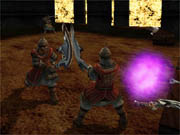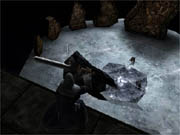Human Head's Rune: Halls of Valhalla is unique in a couple of respects. It's an expansion pack that's also a budget-priced stand-alone product. And since it includes exactly zero single-player levels and no support for computer-controlled bots, it's also one of the few exclusively multiplayer games ever released. If you're already familiar with last year's Viking action game, Rune, and weren't impressed with its multiplayer experience to begin with, then you might as well skip the rest of this review. Halls of Valhalla isn't going to change your mind. If for some reason you did enjoy Rune's lackluster deathmatch mode, you still might want to hold off on Halls of Valhalla. It simply takes the weakest part of the original game and repackages it with a few ultimately inconsequential bonuses--and then it ends up being even less impressive than that description.
Here's a listing of features that are not included in the game:
- Single-player levels
- Bot support
- New weapons
- New rune powers
- New animations for any of the new player models
While it's understandable--if grudgingly--that no new single-player maps would be included in a multiplayer expansion, the lack of even one new weapon or rune power is a letdown and a drawback. What you do get are 34 new multiplayer maps along with the original seven, 15 new character skins, and two new gameplay modes: headball and arena.

Arena is a formalized version of a one-on-one (or two-on-two, or three-on-three) deathmatch variant that has been informally implemented for some time within the small community of Rune players. It's similar to the popular Rocket Arena mod for the Quake series. You take turns entering the combat arena. The winner (or winners in the case of two vs. two and three vs. three) stay in the arena to meet the next challengers, while the losers are respawned in a spectator lounge where they can rearm before queuing up to reenter the battle. The biggest problem with this mode is that there's too much downtime while you're waiting for the next fight, an issue Rocket Arena addressed by including multiple combat zones within a single map. The level designers have tried to make the wait a little less onerous by including some time-killing gimmicks in most of the levels, such as a knife-throwing game, horns to blow, drums to beat, and gongs to bang. One map even features a head dispenser. While these are funny the first time you come across them, they're no substitute for actually playing. Compounding the problem, the spectator lounge often doesn't offer a very good view of the combat zone or is placed so high above it that the combatants look like tiny medieval ants. Since there's no option to become a disembodied observer, as in Rocket Arena, Counter-Strike, and other online games, you can't really get a good look at the action and are usually stuck trying to wring some pleasure out of the head dispenser.
Headball is halfway between vanilla deathmatch and capture the flag. The basic idea is to find (or manually sever) a head, pick it up, and then toss it into a "goal" area for points. Imagine capture the flag, if the flag randomly popped out of an enemy's corpse. It's enjoyable for short periods, but it generally retains the chaotic sense of deathmatch--of Rune deathmatch in particular--and it isn't especially suited to deep team tactics. Since the "flag" can appear pretty much anywhere at any time, it's tough to coordinate a solid offensive and defensive strategy. One especially annoying problem is that, for some reason, picking up dropped weapons takes priority over picking up severed heads. So when you manage to knock someone's block off, you'll often have to bend over a few times in order to finally grab it out of a pile of weapons, probably all the while as you're getting clubbed by your other enemies during the lengthy "picking up" animation.
Using populated servers as a metric, headball appears to be running significantly behind Arena in terms of popularity. Which leads to another potential issue: A multiplayer-only game is only as good as the number of people playing it. A week after its release, Halls of Valhalla generally has fewer than a hundred players at any given time. Most people are playing standard deathmatch (and honestly, many of those may simply be playing the original Rune); only about a quarter of them are playing either of the two new modes. Even after several patches, Rune isn't especially friendly to high pings, so a large variety of servers is particularly important. It's possible that the number of active players may increase, but in the absence of any single-player content whatsoever, without people to play with, you're out of luck. It's a gamble you have to decide whether or not you're willing to take, and it might not be much of a gamble at all when you consider that Halls of Valhalla really doesn't have that much to offer.

Unremarkable new gameplay modes and calculated risks aside, Halls of Valhalla shares its biggest failings with the original Rune: The melee combat is overly simplistic, the weapons are all too similar despite their appearances, and button mashing is often as successful a tactic as skillful maneuvering. In fact, in an effort to reduce in-game lag, a recent Rune patch (which is included with the game) makes combat even less complex by removing the speed differences associated with retreating and sidestepping vs. moving forward--all player movement now occurs at the same rate, which not only makes combat less interesting, but it also lets players back away from one another very easily rather than be forced to clash.
As a stand-alone product, Halls of Valhalla isn't a good enough game to warrant its purchase, and as an expansion, it doesn't offer enough significant enhancements for the world's dwindling supply of hard-core Rune fanatics. However, the graphics and sound effects are nice.